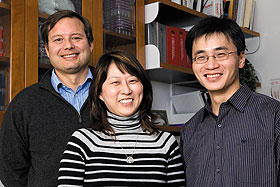  |
| HOME | THIS ISSUE | CALENDAR | GRANTS | BACK ISSUES | < BACK | NEXT > |
Developmental brain disorder can be reversed, say researchers by Elizabeth Omara-Otunnu - February 2, 2009 |
||||
| Research by a UConn neurobiologist has demonstrated that a developmental brain disorder that causes a predisposition to seizures can be reversed. The research, by a team led by Joseph LoTurco, a professor of physiology and neurobiology in the College of Liberal Arts and Sciences, was the cover article in the January issue of the biomedical research journal Nature Medicine. “We showed that adding back a normal gene in a brain that has already developed the wrong way can reverse a previously formed developmental malformation,” LoTurco says. The cerebral cortex is a structure within the brain that plays a key role in memory, attention, perception, thought, and language. Its layered structure is formed during development by the migration of neurons. The researchers focused on a malformation that happens early in fetal development that is a known risk factor for epilepsy. The malformation is linked to mutations in a certain gene known as Dcx or doublecortin. LoTurco says patients who have a mutation in this gene often have a secondary cortex, a new grouping of cells underneath the normal cortex, and 90 percent of them have a seizure disorder. In previous research, published in Nature Neuroscience in 2003 and in Cerebral Cortex in 2006, LoTurco’s team showed that by manipulating the Dcx gene in utero, the malformation can be prevented from occurring. The latest findings show that a malformation that has already formed can be reversed and shrunk after birth by re-expression of the Dcx gene within the malformation. The researchers also found that the predisposition to seizures in treated rats was no greater than in those without the malformation; whereas those with the malformation that were left untreated continued to experience seizures. “The research takes advantage of developmental plasticity in the nervous system,” LoTurco says.
He says the findings may ultimately make it possible for humans with this developmental disorder to be treated through gene therapy or pharmaceutical therapy, though that goes beyond the scope of his lab. “We’re basic scientists,” he says. “This research is proof of concept. Our question was, ‘Does the brain have the capacity to recover from what had been considered a permanent malformation?’ We showed that it does.” He notes that most of the previous research related to developmental malformations in the brain has focused on trying to understand how genetic defects or environmental insults cause the disruption in development. “It’s rarely been asked, ‘What’s the point of no return?’” he says. LoTurco says there is a lot more research to be done in this area. His group is currently investigating the reversibility of other forms of structural malformations in the brain. Another avenue to explore is whether the point of reversibility can be extended into later stages of brain development. “We don’t know the limits of when structural plasticities can be induced,” he says. “We’re interested in categorizing types of developmental malformations, and in determining when they can be reversed and whether we can extend this point to later periods in development.” In addition to LoTurco, the paper’s co-authors include two of his former postdoctoral fellows, Jean-Bernard Manent (the lead author) and Murugan Paramasivam, and two UConn graduate students, Yu Wang and Yoon Jeung Chang. |
| ADVANCE HOME |

